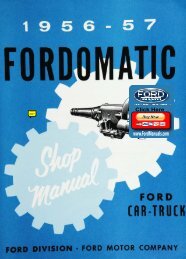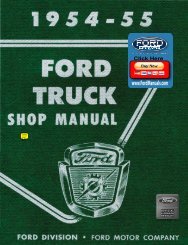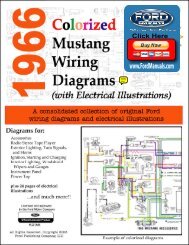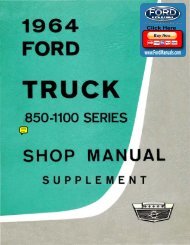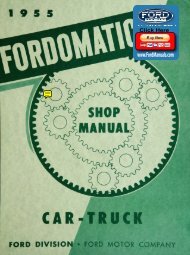DEMO - 1956 Ford Car Shop Manual - FordManuals.com
DEMO - 1956 Ford Car Shop Manual - FordManuals.com
DEMO - 1956 Ford Car Shop Manual - FordManuals.com
- No tags were found...
Create successful ePaper yourself
Turn your PDF publications into a flip-book with our unique Google optimized e-Paper software.
Cam20 Chapter 1 General Engine Overhaul, Inspection, and Repairperformance is noted and all other checks, suchDial Indicatoras carburetion, ignition timing, etc., fail to correct thetrouble. The following procedure can be used to determine if the valve timing is correct with the engine installed in the car.BE SURETO PLACEINDICATOR TIPIN CENTEROF PUSHROD CUPThe procedure checks the cam timing by using theopening side of number 1 intake cam lobe. At this point1of crankshaft rotation is equal to approximately0.0004 inch change in cam lift.Remove the rocker arm cover on the 6-cylinderengine. On 8-cylinder engines, remove the right rockerarm cover.Back off the number 1intake valve adjusting screw,Fig. 22 Camshaft Lobe Lift Check Typical6607then slide the rocker arm assembly to one side andsecure it in this position. Make sure the push rod is inthe tappet socket, then install a dial indicator in such amanner as to have the actuating point of the indicatorin the push rod socket and in the same plane as the pushAdjust the lash on the following valves:No. 1 ExhaustNo. 1 IntakeNo. 4 ExhaustNo. 2 IntakeNo. 5-ExhaustNo. 7-IntakeRotate the engine 180 or V2 turn (this puts number4 piston on T.D.C.)and adjust the following valves:No. 6 ExhaustNo. 4 IntakeNo. 8-ExhaustNo. 5 IntakeRotate the engine 270, or 3A turn from 180 (thisputs number 3 piston on T.D.C.)and adjust the following valves :(b)No. 2-ExhaustNo. 3-ExhaustNo. 7-ExhaustNo. 3-IntakeNo. 6-IntakeNo. 8-IntakeFinal Adjustment. Run the engine for a minimum of 30 minutes at approximately1200 r.p.m. inorder to stabilize engine temperatures. With the engineidling, check the valve lash. Adjust the lash, if necessary(fig. 21). Install the rocker arm covers.e. Valve Timing.Valve timingchecks should be made when poorenginerod movement (fig. 22). Turn the engine slowly (ateither the crankshaft damper bolt or flywheel) untilthe tappet is on the heel of the cam lobe. Zero the dialindicator and continue turning the engine slowly untilthe desired lift is obtained (Table 1). Compare thedegrees on the pulleyDisplacement)with specifications.Table 1 Valve Timing SpecificationsEngine Intake Valve Opens Crankshaft(Cubic Inch Degrees at Cam Lift223272, 2922412.016BTDC@.016BTDC@LiftCam Liftand 312If the valve timing is not within specifications, checkfor a bent timing pointer. Bring the number 1 piston toT.D.C. and see if the timing pointer is aligned with theT.D.C. mark on the crankshaft pulley or damper. If thepointer is not at fault, check the timing chain, camshaftsprocket, crankshaft sprocket, camshaft, and crankshaftpulley, in the order of accessibility.6. TIMING CHAIN, SPROCKETS, AND CAMSHAFTa. TimingChain and Sprockets.To measure timing chain deflection (fig. 23), take upthe slack on the left side (as viewed from the front)of the chain by rotating the crankshaft in a clockwisedirection. Establish a reference point on the block andmeasure from this point to the chain. Rotate the crankshaft to move all the slack to the left side. With thefingers, move the chain toward the original referencepoint and measure the distance between the referencepoint and the chain. If the difference between the twomeasurements (which is the slack)exceeds y% inch,replace the timing( 1 )chain and/or sprockets.INSPECTION. Inspect the sprockets for worn ordamaged teeth. Inspect the chain for broken links.



